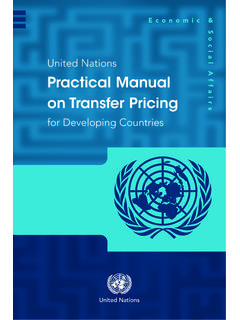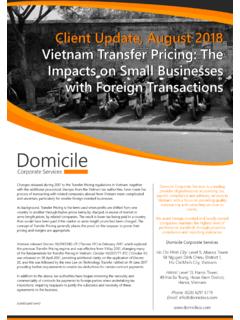Transcription of Chapter 1 An Introduction to Transfer Pricing - …
1 Page 1 of 35 Background Paper Working Draft Chapter 1 An Introduction to Transfer Pricing [This paper is essentially a paper prepared by Members of the UN Tax Committee s Subcommittee on Practical Transfer Pricing Issues, but includes some Secretariat drafting and suggestions not yet considered by them the Secretariat takes responsibility for any relevant errors and omissions.] Table of Contents Section No. Title Page Number 1 What is Transfer Pricing ? 2 2 Basic Issues Underlying Transfer Pricing 4 3 Evolution of Transfer Pricing 6 4 Concepts in Transfer Pricing 9 5 Transfer Pricing Methods 20 6 Special Issues Related to Transfer Pricing 21 7 Transfer Pricing in Treaties 24 8 Transfer Pricing in Domestic Law 27 9 Global Transfer Pricing Regimes 31 10 Transfer Pricing as a Current and Future Issue for Developing Countries 32 11 Summary and Conclusions 353 Page 2 of 35 1.
2 What is Transfer Pricing ? This introductory Chapter intends to give a brief outline of the subject of Transfer Pricing and addresses the practical issues and concerns surrounding it, especially issues faced by, and approaches taken by, developing countries. Many of the issues discussed in the Introduction are dealt with in greater detail in later chapters. Rapid advances in technology, transportation and communication have given rise to a large number of multinational enterprises (MNEs) which have the flexibility to place their enterprises and activities anywhere in the world. The fact is that a significant volume of global trade nowadays consists of international transfers of goods and services, capital (such as money) and intangibles (such as intellectual property) within a MNE group; such transfers are called intra group transactions.
3 There is evidence that intra group trade is growing steadily and arguably accounts for more than 30 per cent of all international transactions. Furthermore transactions involving intangibles and multi tiered services constitute a rapidly growing proportion of an MNE s commercial transactions and have greatly increased the complexities involved in analysing and understanding such transactions. The structure of transactions within an MNE group (the component parts of which, such as companies, are also called associated enterprises in the language of Transfer Pricing ) is determined by a combination of the market and group driven forces which can differ from the open market conditions operating between independent entities.
4 Thus, a large and growing number of international transactions are no longer governed entirely by market forces, but by forces which are driven by the common interests of the entities of a group. In such a situation, it becomes important to establish the right price, called the Transfer price , for intra group, cross border Transfer of goods, intangibles and services. Transfer Pricing is the general term for the Pricing of cross border, intra firm transactions between related parties. Transfer Pricing therefore refers to the setting of prices at which transactions occur involving the Transfer of property or services between associated enterprises, forming part of an MNE group.
5 These transactions are also referred to as controlled transactions, as distinct from uncontrolled transactions between companies that, for example, are not associated and can be assumed to operate independently ( on an arm s length basis ) in reaching terms for such transactions. It follows that, with the need to set such prices being a normal incident of how MNEs must operate, Transfer Pricing by itself does not necessarily involve tax avoidance. It is where the Pricing does not accord with applicable norms internationally or at domestic law that we are entering into areas more properly called mispricing , incorrect Pricing , unjustified Page 3 of 35 Pricing or similar, and where issues of tax avoidance and evasion may arise.
6 A few examples illustrate these points: Consider a profitable computer group in country A that buys flash memory drives from its own subsidiary in country B: how much the parent country A company pays its subsidiary country B company (the Transfer price ) will determine how much profit the country B unit reports and how much local tax it pays. If the parent pays below normal market prices, the country B unit may appear to be in financial difficulty, even if the group as a whole shows a reasonable profit margin when the completed computer is sold. From the perspective of the tax authorities, country A s tax authorities might agree with the profit reported at their end by the computer group in country A, but their country B counterparts may not agree they may not have the expected profit to tax on their side of the operation.
7 If the computer company in country A bought its flash memory drives from an independent company in country B it would pay the market price, and the supplier would pay taxes on its own profits in the normal way. This approach gives scope for the parent or subsidiary, whichever is in a low tax jurisdiction, to be shown making a higher profit by fixing the Transfer price appropriately and thereby minimising its tax incidence. So, when the various parts of the organisation are under some form of common control, it may mean that Transfer prices are not subject to the full play of market forces and the correct arm s length price, or at least an arm s length range of prices (an issue discussed further below) needs to be arrived at.
8 Consider next the example of a high end watch manufacturer in country A that distributes its watches through a subsidiary in country B. Let us say the watch costs $1400 to make and it costs the country B subsidiary $100 to distribute it. The company sets a Transfer price of $1500 and the subsidiary unit in country B retails the watch at $1600 in country B. Overall, the company has thus made $100 in profit, on which it is expected to pay tax. However, when the company in country B is audited by country B s tax administration they notice that the distributor itself is not showing any profit: the $1500 Transfer price plus the country B unit s $100 distribution costs are exactly equal to the $1600 retail price.
9 The country B s tax administration wants the Transfer price to be shown as $1400 so that the country B s unit shows the group s $100 profit that would be liable for tax. However this poses a problem for the parent company, as it is already paying tax in country A on the $100 profit per watch shown in its accounts. Since it is a group it is liable for tax in the countries where it operates and in dealing with two different tax authorities it is not possible to just cancel one out against the other. Nor should it be Page 4 of 35 made to pay the tax twice. So, the MNE can end up suffering double taxation on the same profits where there are differences about what constitutes proper Transfer Pricing .
10 The economic reason for associated entities charging Transfer prices for intra group trade is to be able to measure the performance of the individual entities in a multinational group. The individual entities within a multinational company group are separate profit centres and Transfer prices are required to determine the profitability of the entities. Rationally, an entity having a view to its own interests as a distinct legal entity would only acquire products or services from an associated entity if the purchase price was equal to, or cheaper than, prices being charged by unrelated suppliers. This principle applies, conversely, in relation to an entity providing a product or service; it would rationally only sell products or services to an associated entity if the sale price was equal to, or higher than, prices paid by unrelated purchasers.















